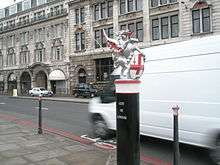Byward Street
Byward Street is a road in the City of London, the historic and financial centre of London. It forms part of the A3211 route and, if travelling eastward, is a short continuation of Lower Thames Street from a junction with Great Tower Street, to Tower Hill. It is located within the City ward of Tower.[1]
History
Constructed between 1895 and 1906 through the Met. and Dist. Railways (City Lines and Extensions) Act, 1882,[2] Byward Street replaced the much older Black Swan Court, itself the successor to a Roman foundation.[3] Its close proximity to the Tower of London[4] and All Hallows-by-the-Tower church[5] ensure a steady stream of visitors,[6] for whom the nearby Underground station at Tower Hill or London Buses services provide easy access to the attractions.[7] A number of retail outlets and restaurants also line Byward Street.
It formed part of the marathon course of the 2012 Olympic and Paralympic Games. The women's Olympic marathon took place on 5 August and the men's on 12 August. The Paralympic marathons were held on 9 September.[8][9]
See also
Other nearby streets:
References
- ↑ "A Dictionary of London", Harben, H.A: London, Herbert Jenkins, 1922
- ↑ "The City of London-a history" Borer,M.I.C. : New York,D.McKay Co, 1978 ISBN 0-09-461880-1
- ↑ Roman thoroughfare
- ↑ Which has not been part of the City, since the creation of Tower Hamlets in the 19th century
- ↑ parish details
- ↑ Tourist hot spot
- ↑ Bus routes
- ↑ http://www.london2012.com/athletics/event/men-marathon/coursemap/
- ↑ http://www.london2012.com/athletics/event/women-marathon/coursemap/
Coordinates: 51°30′35″N 0°04′46″W / 51.50972°N 0.07944°W

